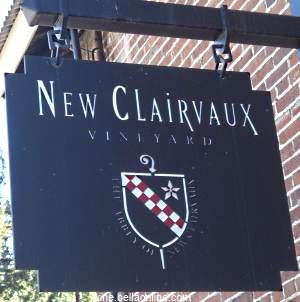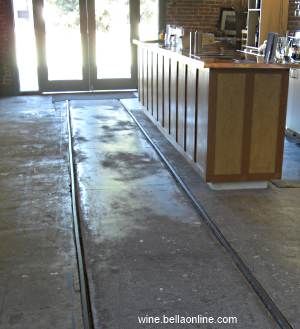New Clairvaux Wines

New Clairvaux Vineyards in Vina, California, is part of the Abbey of New Clairvaux which is the first Cistercian Monastery in the Americas to grow, vinify and bottle its own wine.

The New Clairvaux monks planted their first vineyard in 2000 but they were following in tradition. Not only medieval European Cistercian owned vineyards that had included Burgundy’s world famous Clos de Vougeot but more recently this land was the site of huge vineyards owned by Leland Stanford.
In 1890 his Great Vina Ranch vineyard and distillery was the world’s largest with 4,000 acres of vines. Stanford bequeathed the business to the university he’d founded and during Prohibition the enterprise folded, the vines were removed and the land sold. Walnut trees were planted and they were the main source of income until the Abbey decided to make wine.
Now the monks have 14.5 acres planted to red varieties Syrah, Tempranillo, Graciano, Petite Sirah and Barbera and three whites: Viognier, Albariño and Trebbiano.
The Abbey of New Clairvaux also owns a huge brick building that covers two acres and which once housed Stanford’s winery and distillery. Brandy proved more successful than wine and by 1890 Stanford’s distillery was producing 20% of all California’s brandy. There was capacity to store two million gallons of brandy and the US Government permanently stationed four Treasury revenue agents to oversee the operation.
Now, in one corner is a small modern winery, worked by the monks under the direction of fifth generation winemaker Aimée Sunseri of Nichelini Family Winery in St Helena.
Beside it is the tasting room, with railway tracks in the floor which used to transport brandy barrels from Stanford’s distillery.

There was a small fee for tasting and available were
St James Block Viognier 2011
St James is the name of one of the vineyards, the other is Poor Souls.
This is a pleasantly crisp dry wine without the blowsy-ness I often find in Viognier. 12.6%abv $16
St James Block Tempranillo Noveau 2012
Made in a light beaujolais style by carbonic maceration. 13% abv $14
(carbonic maceration is explained in my article here)
St James Block Tempranillo 2010
Beautiful nose, tight tannins and a smoky finish. Although legally a Tempanillo varietal it includes 11% Graciano. You’d find a similar blend in Spanish Rioja. Very enjoyable and to my taste the best wine and a bargain at $16 13.5% abv.
St James Block Syrah 2010
Plum skin flavours, bit soapy with a sour finish. 14.1% $17
Not open for tasting is Pour Souls Block Petite Sirah at $16.
A must-visit just two minutes walk from the tasting room is New Clairvaux’s amazing 800 year old Chapter House. Read my article about it here)
Talk about wines on our forum.

The New Clairvaux monks planted their first vineyard in 2000 but they were following in tradition. Not only medieval European Cistercian owned vineyards that had included Burgundy’s world famous Clos de Vougeot but more recently this land was the site of huge vineyards owned by Leland Stanford.
In 1890 his Great Vina Ranch vineyard and distillery was the world’s largest with 4,000 acres of vines. Stanford bequeathed the business to the university he’d founded and during Prohibition the enterprise folded, the vines were removed and the land sold. Walnut trees were planted and they were the main source of income until the Abbey decided to make wine.
Now the monks have 14.5 acres planted to red varieties Syrah, Tempranillo, Graciano, Petite Sirah and Barbera and three whites: Viognier, Albariño and Trebbiano.
The Abbey of New Clairvaux also owns a huge brick building that covers two acres and which once housed Stanford’s winery and distillery. Brandy proved more successful than wine and by 1890 Stanford’s distillery was producing 20% of all California’s brandy. There was capacity to store two million gallons of brandy and the US Government permanently stationed four Treasury revenue agents to oversee the operation.
Now, in one corner is a small modern winery, worked by the monks under the direction of fifth generation winemaker Aimée Sunseri of Nichelini Family Winery in St Helena.
Beside it is the tasting room, with railway tracks in the floor which used to transport brandy barrels from Stanford’s distillery.

There was a small fee for tasting and available were
St James Block Viognier 2011
St James is the name of one of the vineyards, the other is Poor Souls.
This is a pleasantly crisp dry wine without the blowsy-ness I often find in Viognier. 12.6%abv $16
St James Block Tempranillo Noveau 2012
Made in a light beaujolais style by carbonic maceration. 13% abv $14
(carbonic maceration is explained in my article here)
St James Block Tempranillo 2010
Beautiful nose, tight tannins and a smoky finish. Although legally a Tempanillo varietal it includes 11% Graciano. You’d find a similar blend in Spanish Rioja. Very enjoyable and to my taste the best wine and a bargain at $16 13.5% abv.
St James Block Syrah 2010
Plum skin flavours, bit soapy with a sour finish. 14.1% $17
Not open for tasting is Pour Souls Block Petite Sirah at $16.
A must-visit just two minutes walk from the tasting room is New Clairvaux’s amazing 800 year old Chapter House. Read my article about it here)
Talk about wines on our forum.
Peter F May is the author of Marilyn Merlot and the Naked Grape: Odd Wines from Around the World which features more than 100 wine labels and the stories behind them, and PINOTAGE: Behind the Legends of South Africa’s Own Wine which tells the story behind the Pinotage wine and grape, also available for the Kindle. |
You Should Also Read:
New Clairvaux Vineyards 800 Year Old Building

Related Articles
Editor's Picks Articles
Top Ten Articles
Previous Features
Site Map
Content copyright © 2023 by Peter F May. All rights reserved.
This content was written by Peter F May. If you wish to use this content in any manner, you need written permission. Contact Peter F May for details.


